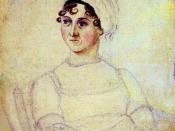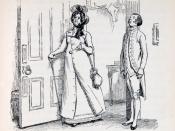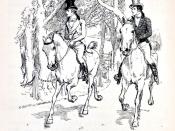The themes of class and class consciousness, as seen in Pride and Prejudice, strictly regulate the daily lives of middle and upper class men and women at this period in England. In her novel, Pride and Prejudice, Jane Austen portrays class-consciousness mainly through the relationship between Darcy and Elizabeth as it was from when they first met until the time when Elizabeth visits Pemberley . Austin also shows class-consciousness through many of the other characters in the novel, such as Mr. Collins, who spends most of his time praising and exaggerating the grandeur of his upper-class patron, Lady Catherine de Bourgh. Though Mr. Collins seems to be an extreme example, there are many other class-conscious characters in this novel as well. His perception of the importance of class is shared, among others, by Lady Catherine de Bourgh, Miss Bingley, and Wickham. Mr. Collins's views are merely the most extreme and obvious.
Jane Austen shows the ability of people to overcome these class boundaries and prejudices with the power of love, through the marriages of Elizabeth and Darcy, and Jane and Bingley, therefore implying that such prejudices are meaningless, unnecessary, and unproductive.
Mr. Collins and Lady Catherine de Bourgh are some of the more extreme examples of class-consciousness within Pride and Prejudice, and are being used by Austin to accentuate the themes of class and class-consciousness, which exists in many people throughout various levels or classes of society. "I am happy on every occasion to offer those little delicate compliments...her daughter seemed to be born a duchess, and that the most elevated rank, instead of giving her consequence, would be adorned by her." (P.66) This quote, in which Mr. Collins is addressing the Bennets regarding Lady Catherine de Bourgh, is one of the many examples of...


